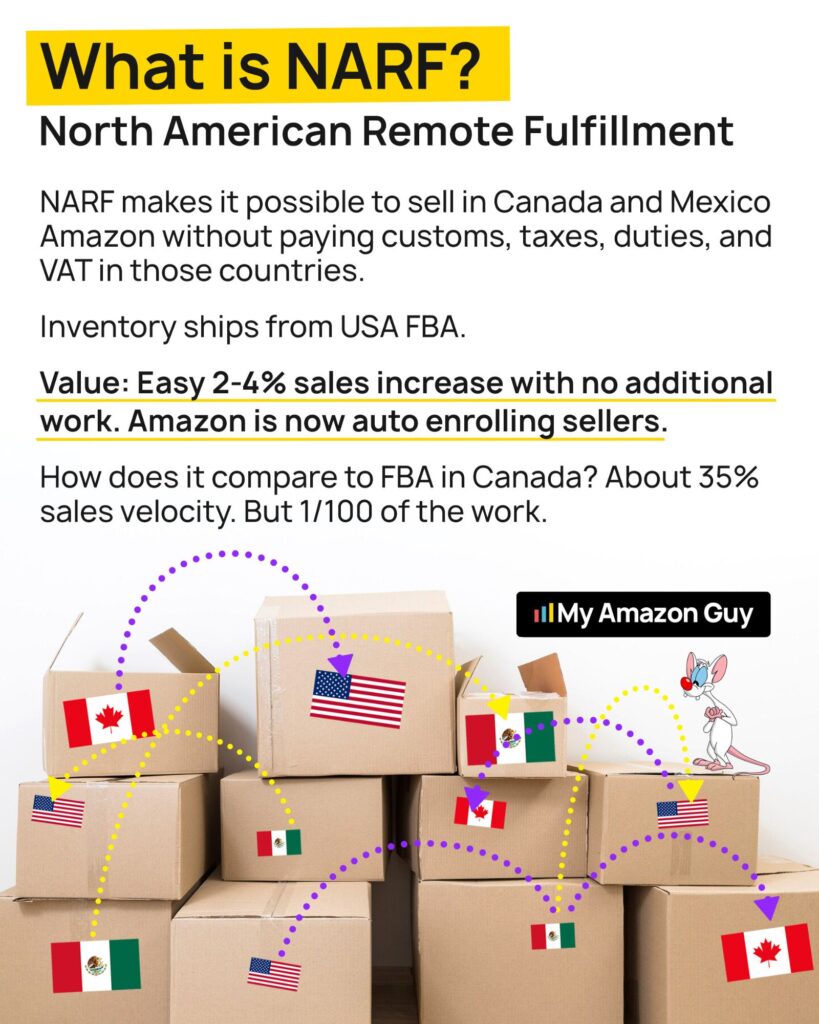Planning to expand to Amazon Canada? Before you do, you need to know the common mistakes sellers make so you can prevent them or fix them fast.
Once sellers find success on the U.S. marketplace, their next goal is often to tap into international markets like Canada. It makes sense since it’s a natural move to grow your audience, reach more customers, and increase revenue.
But here’s the catch: expanding to Amazon Canada can backfire if you walk in blind. Many sellers make avoidable mistakes that end up costing them time, money, and momentum.
This guide breaks down the top 10 mistakes sellers make when expanding from Amazon U.S. to Canada, like skipping compliance, ignoring bilingual listings, and mismanaging taxes or shipping. It shows you how to avoid these issues so you can expand smoothly and protect your profits.
Table of Contents
Ready to Launch on Amazon Canada?
Don’t wing your expansion. Work with experts who know the platform, the rules, and what actually gets results.
Why Expand to Amazon Canada?
Amazon holds over 40% of the Canadian e-commerce market, making it the top online retailer in the country. That’s why many U.S. sellers looking to expand internationally start with Canada, because it’s familiar, profitable, and relatively easy to enter.
Canada has a strong Prime customer base, high online shopping adoption, and less competition compared to the U.S. With the right setup, sellers can tap into a new revenue stream without reinventing their entire business.
Common Mistakes Sellers Make When Expanding to Amazon Canada
Learning about the common mistakes sellers make can help you avoid costly delays, compliance issues, and wasted effort. Here are the top 10 mistakes you need to look out for:
Mistake #1: Skipping Canadian Compliance Requirements
Just because Amazon U.S. and Amazon Canada fall under the same brand doesn’t mean they follow the same rules. Some U.S. sellers make the mistake of assuming their U.S. compliance setup will carry over to Canada, only to get flagged, restricted, or delayed due to unmet Canadian requirements.
Avoid this by always checking the compliance and listing requirements specific to Amazon.ca, especially for gated categories, regulated products, or anything that may need French labeling. If you’re selling products like supplements, electronics, or items with safety certifications, make sure they meet Canadian standards before listing them.
Mistake #2: Failing to Research the Canadian Market
Part of an effective Amazon selling strategy is doing proper market research; without it, you risk launching a product that won’t sell or entering a category with unexpected challenges. But there are some sellers who assume that just because a product did well in the U.S., it’ll automatically succeed in Canada, and they end up with stuck inventory and zero momentum.
Never skip market research. Use tools like Brand Analytics, Amazon’s Product Opportunity Explorer, and even external tools like Jungle Scout to study demand, competition levels, and search trends in the Canadian marketplace.
Mistake #3: No Expansion Strategy or Launch Plan
Expanding to Amazon Canada means you’re entering a new marketplace with different customers, tax rules, fulfillment options, and compliance requirements. That’s why you need a tailored expansion strategy or a specific product launch plan built for Canada.
Still, there are sellers who skip this step entirely because they’re too eager to expand and rush in without a plan. To avoid this, map out your Canadian launch just like you did in the U.S., and this should include pricing, inventory allocation, marketing strategy, and compliance checkpoints.
Mistake #4: Ignoring Canadian Customer Behavior
Did you know that 97% of Canadians prefer to buy from Canadian-owned businesses or brands that feel local? Without understanding this and other buying habits, some sellers jump into Amazon Canada without adjusting their strategy, leading to poor sales and missed connections with customers.
Prevent this by making sure you research your Canadian target audience. Pay attention to cultural preferences, spelling differences, and buying trends so you can align your listings, branding, and messaging accordingly.
Mistake #5: Failing to Localize
Localization plays a big role in online selling because it directly influences customer trust and purchase decisions, since 75% of consumers prefer shopping in their native language. So when sellers expand to Amazon Canada, they need to take this seriously instead of ignoring it altogether.
What’s more, Canada has strict regulations requiring French translations in product listings and on packaging, especially for certain categories. If sellers fail to meet these requirements, they risk getting their listings removed or, worse, face account suspensions.
Want More Sales from Amazon Canada?
You’re leaving money on the table if you’re not selling in Canada. Let us build and optimize your Canadian presence.
Mistake #6: Pricing Without Factoring in Import Fees and Duties
When pricing products to sell on Amazon Canada, you need to factor in everything, and that includes the import fees, duties, and customs charges that come with cross-border selling. Many sellers overlook these costs and end up pricing their products too low, which leads to lost profits or even operating at a loss.
To prevent this, ensure every penny you spend on shipping, customs clearance, brokerage, and taxes is included in your pricing formula. Accurate landed cost calculations are key to protecting your margins and staying competitive in the Canadian market.
Mistake #7: Not Accounting for Exchange Rates
Ignoring currency conversion can mess with your pricing strategy. Even a small fluctuation in exchange rates could shrink your margins without you realizing it.
It’s important to track the current USD to CAD exchange rate and bake that into your pricing and profit projections. Don’t assume the numbers will balance out; factor in the conversion costs and update regularly.
Mistake #8: Ignoring Amazon Canada SEO and Advertising
Sellers focus on SEO and advertising because both drive traffic and conversions, but what works for U.S. customers won’t always work for Canadians. The keywords, customer behavior, and even seasonal trends can differ, yet some sellers just copy-paste their U.S. strategy into Canada and hope for the best.
Instead of making this mistake, tailor your SEO by doing fresh keyword research specific to Amazon.ca and adjusting your Amazon PPC campaigns for the Canadian audience. This ensures your product gets seen by the right shoppers and that your ad spend isn’t going down the drain.
Mistake #9: Fulfilling Canadian Orders from the U.S. (When Not Ideal)
Some sellers try to keep it simple by fulfilling Canadian orders from their U.S. FBA inventory through programs like NARF. While it’s low-effort, it usually results in slow delivery, extra fees for customers, and weaker sales performance.
To truly grow your Canadian sales, you should ship inventory directly to Amazon Canada FBA. Yes, it takes more work, like arranging your own carrier, handling customs paperwork, and scheduling delivery appointments, but it unlocks faster shipping, lower costs for customers, and stronger long-term results.
Mistake #10: Trying to Expand Internationally Without Help
Most Amazon sellers start out alone, managing everything from listing creation and customer service to logistics and PPC. This is because, in the beginning, wearing all the hats feels necessary, and sometimes even faster.
However, when you want to expand your business to another country, such as Canada, you will need to get help, especially because you’re dealing with tax requirements, customs, foreign fulfillment, and customer expectations you may not fully understand. Bringing in experts, whether it’s a logistics partner or an Amazon agency with international experience, will save you from avoidable delays, penalties, and wasted ad spend.
Frequently Asked Questions
Is expanding in Amazon Canada worth it?
Yes, if you’re already selling in the U.S., expanding to Canada gives you access to millions of additional shoppers with relatively low competition.
What documents are required for an Amazon seller in Canada?
You’ll need a business number (BN) from the CRA, your U.S. tax ID (EIN or SSN), a government-issued ID, and a bank account that can receive Canadian dollars.
How do I set my Amazon to Canada?
Go to Seller Central, click “Inventory” > “Sell Globally”, then link your North American accounts and enable Canada as a marketplace.
Ready to Sell in Canada? Don’t Make These Costly Mistakes
More and more sellers are expanding to other marketplaces because they see how much more they can earn once they go global. And one of the most popular marketplaces outside the U.S. is Amazon Canada.
However, when sellers jump into a new marketplace, they tend to make a lot of mistakes, especially if they’re unfamiliar with the territory. That’s why learning these common mistakes is a must if you want to protect your profits and avoid unnecessary headaches.
Looking for a trusted team to help you expand to Amazon Canada? Let our full-service Amazon agency guide you; our experts know exactly what it takes to scale your brand the right way.
Amazon Canada Isn’t a Shortcut, It’s a Strategy
You need localized listings, pricing, and logistics to succeed. Our team handles it all so you can focus on growth.




